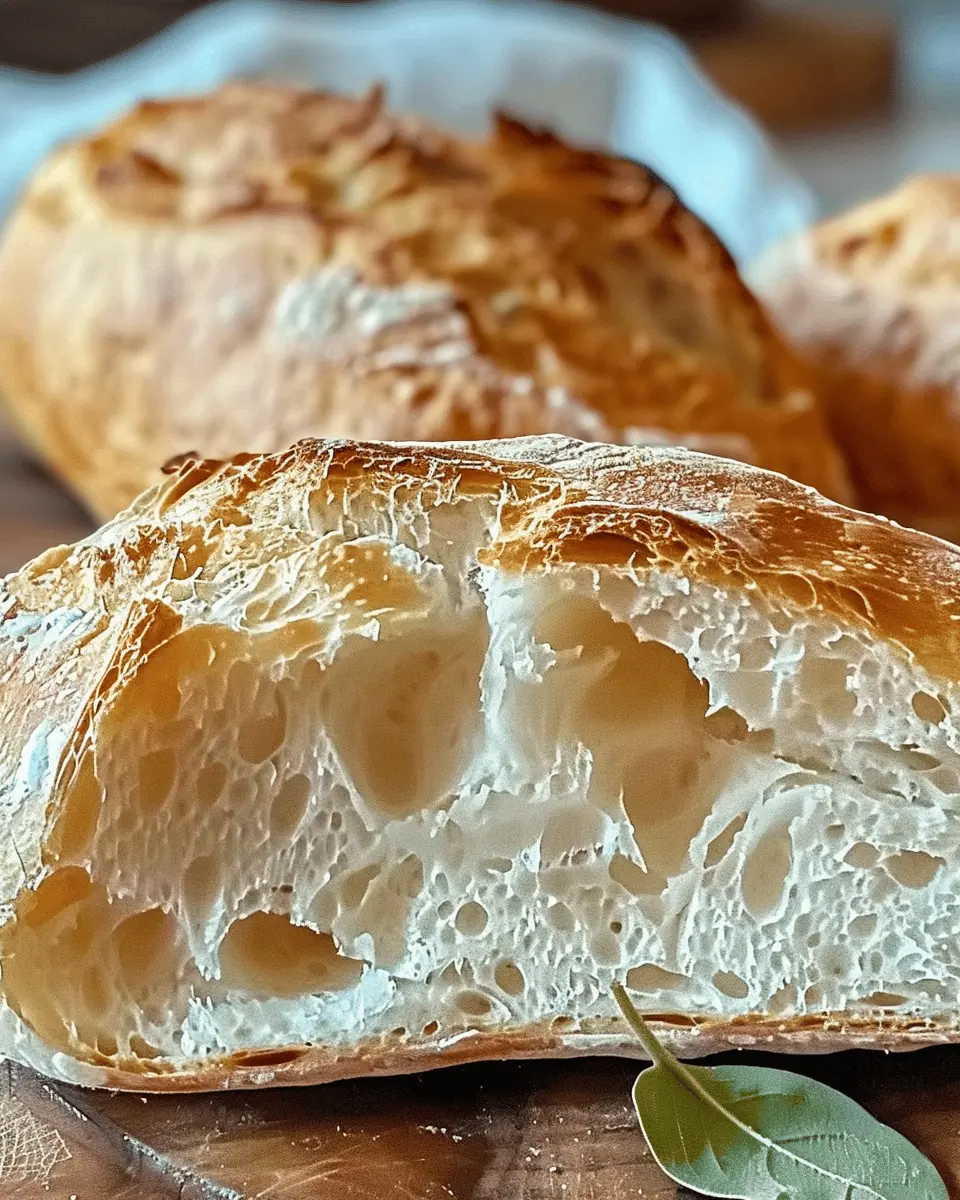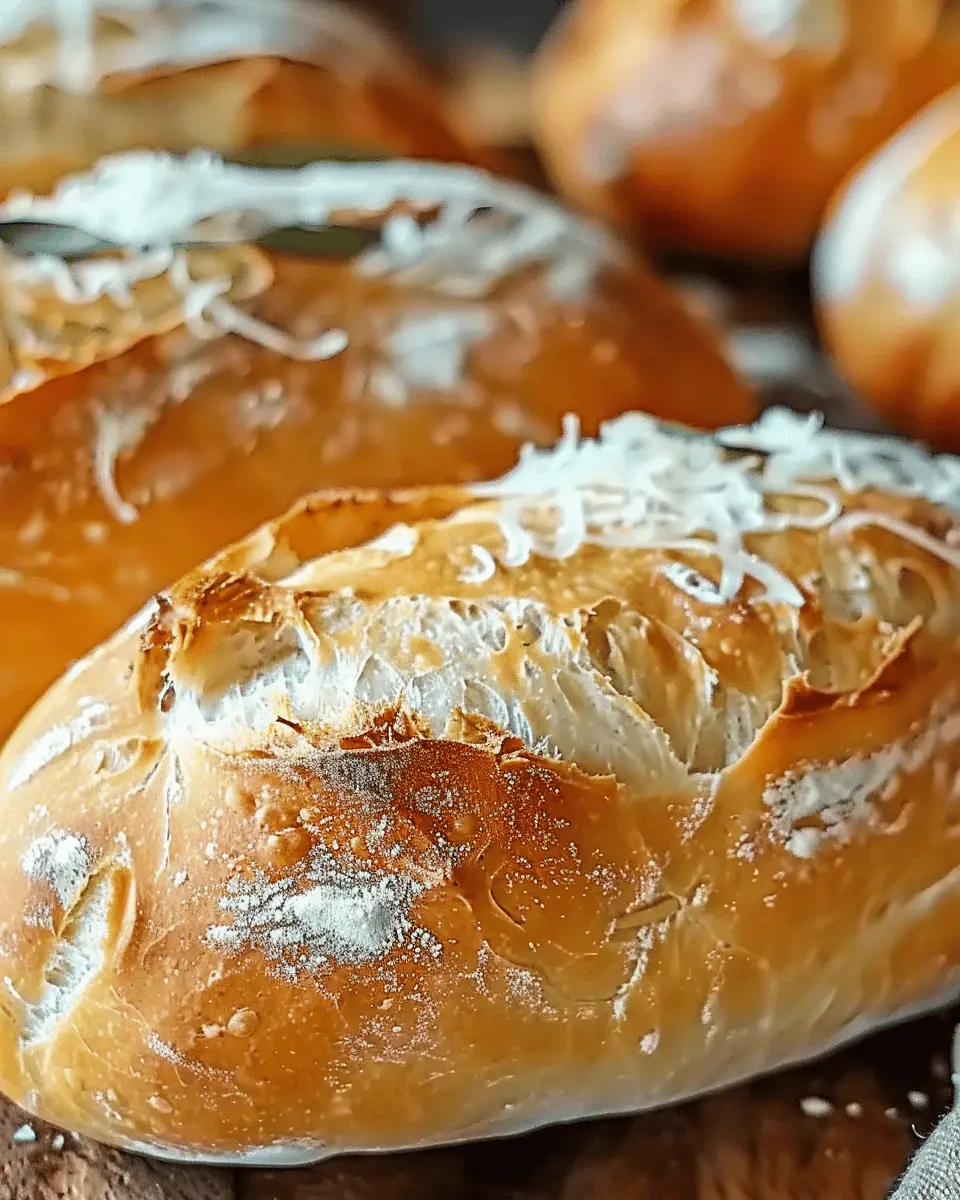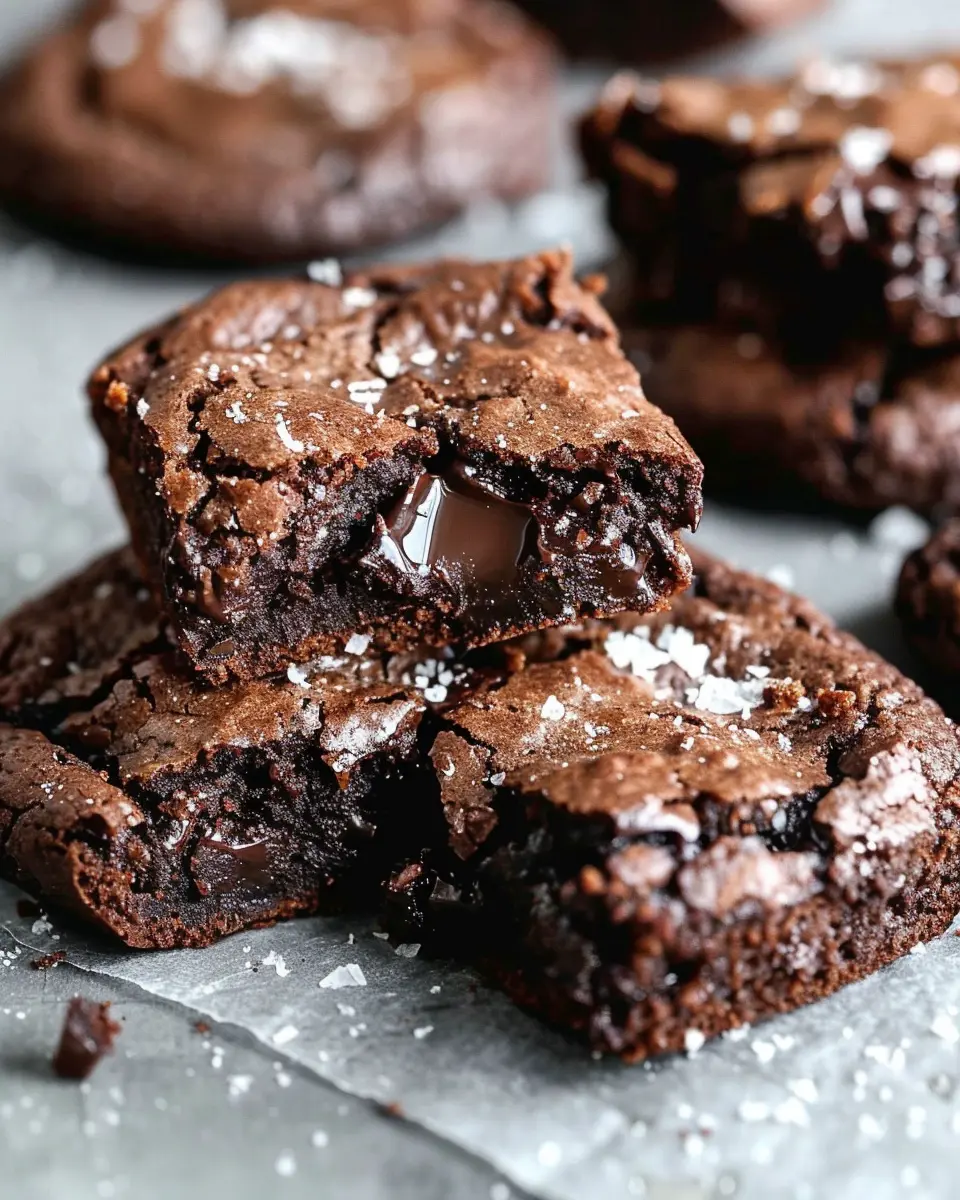Introduction to Crusty Italian Bread
Baking your own crusty Italian bread is more than just a culinary adventure; it’s a delightful experience that fills your home with that unbeatable aroma of freshly baked bread. Have you ever thought about the satisfaction that comes from taking a warm loaf out of the oven, its crust golden-brown, crackling just as you slice into it? This is the kind of joy that makes the time spent kneading and waiting for dough to rise feel completely worth it.
Why bake your own crusty Italian bread?
Considering the numerous benefits of making your own bread can lead you to embrace this craft. First and foremost, baking your own crusty Italian bread allows you to control the ingredients. You can choose high-quality flour and fresh yeast, avoiding preservatives and other additives often found in store-bought options. This is especially significant when you think about how many folks are looking to eat healthier nowadays.
But let’s be honest: it’s not just about what goes into the bread. It’s also about the process itself. The act of mixing, kneading, and shaping dough can be therapeutic. As you dive into this culinary art, you’ll likely find it incredibly rewarding to learn the subtle nuances of yeast fermentation and bread development. Plus, there’s a certain magic in the way simple ingredients like flour, water, salt, and yeast can transform into something so delicious.
Another reason to embark on this baking journey is the community aspect. Bread has been a cornerstone of cultures worldwide, and sharing your homemade loaves with friends and family can be a beautiful way to connect. Whether it’s at a cozy brunch, a dinner gathering, or simply to enjoy with a warm bowl of soup, your crusty Italian bread can be the star of the show.
If you’re curious about the science behind bread-making or want to explore various techniques, resources like King Arthur Baking provide fantastic insights and tips on perfecting your craft. Now, let’s get to cooking—your very own crusty Italian bread awaits!

Ingredients for Crusty Italian Bread
Creating the perfect crusty Italian bread starts with a few essential ingredients that work together to produce a delicious loaf. Here’s what you’ll need:
- Bread Flour: About 4 cups is ideal for that airy texture. Bread flour has a higher protein content, giving your loaf the strength it needs to rise beautifully.
- Water: Around 1.5 cups of warm water (100°F) brings the dough to life and activates the yeast. Opt for filtered or bottled water for the best flavor.
- Active Dry Yeast: A packet (2.25 teaspoons) of yeast is all you need to get that delightful fermentation process started.
- Salt: About 2 teaspoons not only enhances flavor but also helps control the fermenting action of yeast.
- Olive Oil: While optional, adding a tablespoon can enrich your dough’s taste and texture.
These ingredients are not only simple to find, but they also form the foundation of any artisan bread. For a deeper dive into bread-making techniques, consider checking out resources from King Arthur Baking or The Bread Lab. Ready to bake? Your crusty Italian bread adventure begins here!
Preparing Crusty Italian Bread
Making crusty Italian bread at home is not just a delicious endeavor; it’s also incredibly rewarding. It might seem a bit daunting at first, but with patience and a bit of practice, you’ll master the art of bread making in no time. Let’s dive into the delightful journey of preparing this rustic staple!
Gather your ingredients
Before you embark on making your crusty Italian bread, you’ll need to gather some basic ingredients:
- 4 cups all-purpose flour
- 1 ½ cups warm water (around 110°F)
- 2 teaspoons salt
- 2 teaspoons active dry yeast
- 1 teaspoon sugar
These ingredients are simple, yet they come together to create magic. Opt for good-quality flour and ensure your yeast is fresh for the best results. You can read more about flour choices here.
Activate the yeast
Start by activating your yeast. In a small bowl, mix the warm water with the sugar, then sprinkle the yeast on top. Let it sit for about 5-10 minutes. This step is crucial as it wakes up the yeast and prepares it to work its magic. You should see bubbling and foaming; that’s how you know it’s alive and kicking!
Mix the dough
In a large mixing bowl, combine the flour and salt. Once your yeast is nice and frothy, add it to the flour mixture. Stir with a wooden spoon until a shaggy dough begins to form. It doesn’t need to be perfect at this stage, but it should come together enough to hold its shape.
Knead for a perfect texture
Now it’s time to knead! Flour your countertop lightly and turn out your dough. Knead it for about 8-10 minutes until it’s smooth and elastic. If you’re unsure about the texture, think of a well-inflated balloon — it should feel pillowy yet firm. This step is essential in developing gluten, which contributes to the bread’s beautiful structure and chewiness.
First rise – patience is key!
Once kneaded, shape your dough into a ball and place it in a greased bowl, turning it to coat. Cover with a kitchen towel or plastic wrap and let it rise in a warm spot for about 1-2 hours, or until it has doubled in size. Patience is key here; during this time, the yeast is working its magic, creating air bubbles that will give your bread that lovely crust.
Preheat the oven
While your dough is rising, it’s a great time to get your oven ready. Set it to 450°F (232°C) to ensure it’s hot enough to give your crusty Italian bread that perfect golden crust. You might also want to place a cast iron skillet or a baking stone inside to preheat, as these will help create steam for a better crust.
Shape the dough
Once your dough has risen, gently punch it down to release the air. Turn it out onto a floured surface and shape it into a round or oval loaf, whatever you prefer. If you enjoy a more artisanal look, you can even create a few slashes on top to help with the final rise and baking.
Second rise – time for some more patience!
After shaping, let your dough rise again on a baking sheet lined with parchment paper. Cover it with a towel and allow it to rise once more for 30-60 minutes. This final rise allows the flavors to develop further while creating that airy texture.
Score and bake the bread
Now comes the thrilling part! Once your dough has puffed up again, it’s time to score the top with a sharp knife or a bread lame. This allows the steam to escape during baking, which helps create that lovely crust. Carefully place your bread into the oven and bake for 25-30 minutes, or until golden brown. The sound of the crust cracking as it bakes is music to any baker’s ears!
Cool and slice
After baking, let your crusty Italian bread cool on a wire rack for at least 30 minutes before slicing. This rest period allows the interior crumb to set properly. Once cooled, slice into thick pieces and enjoy with olive oil, spread some turkey bacon, or make a delicious sandwich.
There you have it—a perfect guide to baking your own crusty Italian bread. With a bit of practice, you’ll be wowing your friends and family with your homemade creations. Happy baking!

Variations on Crusty Italian Bread
Herbed Crusty Italian Bread
Add a burst of flavor to your crusty Italian bread by incorporating fresh herbs into the dough. Basil, rosemary, and thyme work particularly well, bringing a touch of the Mediterranean right to your kitchen. Simply chop up a handful of your chosen herbs and knead them into the dough before the first rise. Want to take it further? Sprinkle some sea salt and cracked pepper on top before baking for an extra flavor boost. Not just delicious, this herbed variation also makes your home smell amazing while it bakes!
Olive and Garlic Crusty Italian Bread
There’s something about the combination of olive oil and garlic that elevates crusty Italian bread to new heights. To make this savory variation, simply add minced garlic and a generous drizzle of high-quality olive oil to your dough. This duo not only enhances the flavor but also creates a beautifully crisp crust. Consider folding in sliced olives, too, for a delightful brininess that pairs wonderfully with soups and salads. Don’t forget to check out this article on the health benefits of incorporating olive oil into your diet!
Both of these variations take that classic crusty Italian bread recipe and transform it into something truly special. They’re perfect for dipping into soups, slathering with butter, or enjoying on their own. So, why not experiment with these exciting flavors? Your taste buds will thank you!
Cooking Tips for Crusty Italian Bread
Creating the perfect crusty Italian bread can be an art, but with a few tips, you’ll be a pro in no time! Here’s how to get that ideal crust and soft interior everyone loves.
Use High-Quality Ingredients
Start with high-protein bread flour; it gives your bread that desirable chew. Brands like King Arthur Flour or Bob’s Red Mill are excellent choices. Fresh yeast makes a noticeable difference, so don’t skimp on that either!
Steam is Your Friend
For that perfect crust, introduce steam into your baking process. Place a pan of hot water at the bottom of your oven when baking. This will create steam, resulting in a beautifully crusty exterior.
Give it Time
Don’t rush the fermentation process. Allow your dough to rise in a warm spot for at least an hour. This gives the flavors time to develop while ensuring a light and airy texture.
The Perfect Shape
When shaping your dough, keep it tight but not overly manipulated; you want to maintain the airy bubbles formed during the rise. A well-shaped loaf enhances both texture and presentation.
Recommended Resources
For more detailed techniques, consider checking resources like King Arthur Baking or Serious Eats. They offer excellent insights and tutorials on artisan bread baking.
With these tips, you’ll be on your way to enjoying freshly baked, crusty Italian bread that impresses family and friends alike!

Serving Suggestions for Crusty Italian Bread
When it comes to crusty Italian bread, the possibilities for serving are endless. This versatile loaf shines in various ways, whether you’re aiming for a cozy dinner or a chic brunch.
Perfect Pairings
-
Dipping Oils and Spices: Start with a simple plate of olive oil infused with fresh herbs like rosemary or basil. It’s an easy yet delicious way to enjoy the bread’s crusty exterior.
-
Hearty Sandwiches: Create a gourmet sandwich using slices of crusty Italian bread layered with savory turkey bacon and creamy avocado for a satisfying lunch.
-
Bruschetta: Toast slices of your bread lightly and top them with diced tomatoes, garlic, and a sprinkle of salt. It’s a classic Italian appetizer that will impress your guests.
-
Goes Well with Soups: Serve your bread alongside hearty dishes like minestrone or a creamy potato soup. The crust is perfect for dipping and soaking up every drop of flavor.
Enjoying with Beverages
Complement your meal with sparkling water or a zesty lemonade. Both beverages balance the rich flavors of your crusty Italian bread without overpowering them.
Incorporate these suggestions in your next dining experience, and watch them transform your crusty Italian bread into a culinary highlight! For more tips, check out this guide on Italian bread recipes.
Time Breakdown for Crusty Italian Bread
When you’re ready to embark on the journey of making crusty Italian bread, knowing how to allocate your time can make the process smoother. Here’s a helpful breakdown to guide you through:
Preparation Time
This crucial step takes about 20 minutes. You’ll mix the ingredients, knead the dough, and let it rise to develop that perfect texture.
Baking Time
Once your dough has risen, it’s time to bake! Expect about 30 to 35 minutes in the oven. You’ll love the aroma wafting through your kitchen during this time.
Total Time
In total, you’re looking at around 1 hour and 10 minutes, not including the rising time, which can take anywhere from 1 to 2 hours. So, grab a book or relax while your dough works its magic.
For more kitchen tips, check out resources like King Arthur Baking to enhance your bread-making skills!
Nutritional Facts for Crusty Italian Bread
When you bake a batch of crusty Italian bread, understanding its nutritional profile can help you enjoy it even more mindfully. Let’s break it down:
Calories
A typical slice of crusty Italian bread contains about 80 to 100 calories. This makes it a great choice for a filling meal or snack without completely derailing your daily calorie intake.
Protein
For those focused on increasing their protein intake, you’ll find that each slice provides around 3 grams of protein. While not extremely high, it’s a nice complement to toppings like turkey bacon or chicken ham.
Sodium
The sodium content in crusty Italian bread varies depending on the recipe but generally hovers around 180 to 250 mg per slice. If you’re watching your sodium intake, pairing your bread with low-sodium spreads or toppings can help balance it out.
For more detailed nutritional information, check reputable sources like the USDA FoodData Central or Calorielab. Enjoy your baking!
FAQs about Crusty Italian Bread
What if my dough doesn’t rise?
If your crusty Italian bread dough hasn’t risen, don’t panic—this can happen for several reasons. The most common culprits are inactive yeast or unsuitable temperatures. Always check the expiration date on your yeast. If you’re using active dry yeast, ensure it’s blooming before mixing it into your dough. Ideally, the water used should be lukewarm (around 110°F). If you suspect your dough might be too cold, try moving it to a warmer spot in your kitchen or consider letting it rise in an oven set to a low temperature (with the oven turned off).
Can I use whole wheat flour?
Absolutely! Substituting whole wheat flour for all-purpose flour can add a nutty flavor and extra nutrition to your crusty Italian bread. However, keep in mind that whole wheat flour absorbs more moisture, so you may need to adjust the liquid in your recipe slightly. Many bakers recommend using a mix of whole wheat and all-purpose flour for the best texture.
How do I store crusty Italian bread?
To keep your crusty Italian bread fresh, it’s best to store it at room temperature in a paper bag rather than plastic, which can make the crust soggy. If you have leftovers, you can also freeze slices. Just make sure they’re tightly wrapped to prevent freezer burn. A great tip is to toast the frozen slices directly from the freezer—this can revive their delicious crustiness!
For more tips on dough rising, you might find this article on baking science helpful. And if you’re curious about whole wheat flour, check out Whole Grains Council. Happy baking!
Conclusion on Crusty Italian Bread
In summary, crusty Italian bread is not just a loaf; it’s an experience. The crunchy exterior that gives way to a soft, airy inside is perfect for soaking up sauces or pairing with hearty meals. Imagine savoring a slice adorned with fresh tomatoes and basil, or served alongside a savory soup. It’s the small pleasures in life, like homemade bread, that truly elevate our dining experiences.
When crafting your own, remember that patience is key! Allow the dough to rise properly, embrace the cooling time, and enjoy the process. This bread is a delightful venture into the world of baking, making your kitchen feel like an Italian bakery. For more delightful recipes, check out King Arthur Baking for tips and inspiration. Happy baking!
Print
Crusty Italian Bread: The Easiest Homemade Delight You’ll Love
Learn how to make crusty Italian bread at home with this easy recipe that everyone will love.
- Total Time: 1 hour 55 minutes
- Yield: 1 loaf 1x
Ingredients
- 4 cups all-purpose flour
- 1 1/2 cups warm water
- 2 teaspoons salt
- 1 teaspoon sugar
- 2 teaspoons active dry yeast
Instructions
- In a large bowl, combine warm water, sugar, and yeast. Let it sit for 5-10 minutes until frothy.
- Add flour and salt to the yeast mixture. Mix until a sticky dough forms.
- Knead the dough on a floured surface for about 10 minutes until smooth.
- Place the dough in a greased bowl, cover, and let rise for 1 hour.
- Preheat your oven to 450°F (230°C).
- Punch down dough, shape it into a round loaf, and place it on a baking sheet.
- Let it rise for another 30 minutes.
- Score the top of the loaf and bake for 30-35 minutes until golden brown.
Notes
- You can add herbs for extra flavor.
- Adjust baking time based on your oven.
- Prep Time: 20 minutes
- Cook Time: 35 minutes
- Category: Bread
- Method: Baking
- Cuisine: Italian
- Diet: Vegetarian
Nutrition
- Serving Size: 1 slice
- Calories: 150
- Sugar: 0.5g
- Sodium: 400mg
- Fat: 1g
- Saturated Fat: 0g
- Unsaturated Fat: 0g
- Trans Fat: 0g
- Carbohydrates: 30g
- Fiber: 1g
- Protein: 5g
- Cholesterol: 0mg
Keywords: Crusty Italian Bread, homemade bread, Italian recipes











